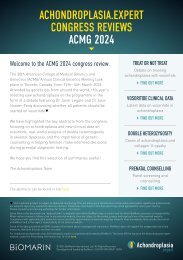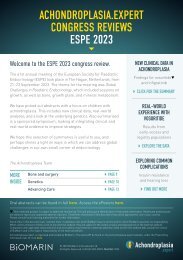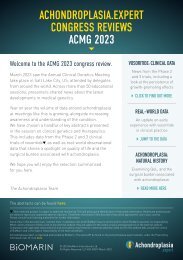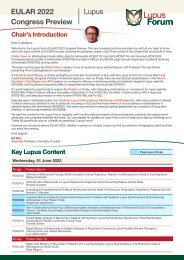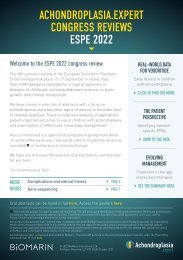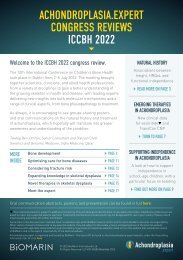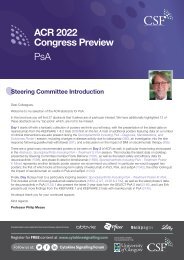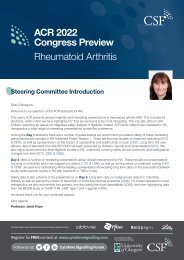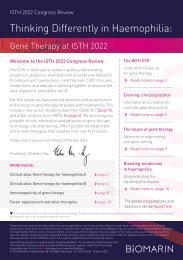ISTH 2021 Congress Review
You also want an ePaper? Increase the reach of your titles
YUMPU automatically turns print PDFs into web optimized ePapers that Google loves.
<strong>ISTH</strong> <strong>2021</strong> Virtual <strong>Congress</strong> <strong>Review</strong><br />
Thinking Differently in Haemophilia:<br />
Gene therapy at <strong>ISTH</strong> <strong>2021</strong><br />
Welcome to the <strong>ISTH</strong> <strong>2021</strong> <strong>Congress</strong> <strong>Review</strong>.<br />
The 29th annual <strong>ISTH</strong> <strong>Congress</strong> welcomed more than<br />
7000 attendees from over 120 countries. We have selected<br />
the most relevant abstracts, plenaries and symposiums to<br />
gene therapy in haemophilia for this review.<br />
Dr Katherine High gave an engaging opening plenary charting<br />
the progress of gene therapy for haemophilia (page 2), and<br />
Professor Edward Tuddenham gave an interesting view of the<br />
history of gene therapy with a focus on the immune response<br />
and potential mechanisms for transaminitis (page 3). New<br />
data was presented from the ROCTAVIAN ® (valoctocogene<br />
roxaparvovec), SPK-8011 and BAY 2599023 programmes in<br />
haemophilia A and etranacogene dezaparvovec in haemophilia B<br />
as well as investigational studies into platelet gene therapy.<br />
I hope you enjoy this summary of the key data from <strong>ISTH</strong> <strong>2021</strong>.<br />
Professor Cem Ar<br />
MORE INSIDE:<br />
Investigating Antibodies to AAV page 12<br />
Liver Health in Gene Therapy page 13<br />
The Impact of Gene Therapy: The Exigency Study page 14<br />
The WFH Gene Therapy Register page 15<br />
Developments in<br />
Haemophilia A<br />
Data from the valoctocogene<br />
roxaparvovec, BAY 2599023*<br />
and SPK-8011* programmes.<br />
Read more on page 4<br />
Developments in<br />
Haemophilia B<br />
5-year results from a study<br />
of AMT-060*, Phase 1/2<br />
data, and abstracts from<br />
the HOPE-B Phase 3 trial of<br />
etranacogene dezaparvovec.<br />
Turn to page 8<br />
Platelet Gene Therapy<br />
Intranasal delivery of<br />
lentiviral vectors, the impact<br />
of platelet aggregation, and<br />
a preconditioning approach<br />
for platelet gene therapy.<br />
Find out more on page 11<br />
The abstract presentations,<br />
plenary presentations and<br />
symposiums can be found here<br />
This medicinal product is subject to additional monitoring. This will allow quick identification of new safety information. Healthcare professionals<br />
are asked to report any suspected adverse reactions.<br />
*Not yet licensed in the EU. Treatments mentioned in this document may not be approved for use in your country. Please consult local<br />
licensing authorities for further information. Some links in this document are “external links” to websites over which BioMarin has no control<br />
and for which BioMarin assumes no responsibility. When visitors choose to follow a link to any external website, they are subject to the cookie,<br />
privacy and legal policies of the external website. Compliance with applicable data protection and accessibility requirements of external websites<br />
linked to from this website falls outside the control of BioMarin and is the explicit responsibility of the external website.<br />
Haemophilia.expert is organised and funded by BioMarin. For Healthcare Professionals Only.<br />
This medicine received a conditional marketing authorisation. The latest API can be found on<br />
the Haemophilia.expert website, under the Prescribing Information tab. Or click here.<br />
Developed and funded by BioMarin. © 2022 BioMarin International Ltd. All Rights Reserved.<br />
EU-ROC-00184 October 2022<br />
1
<strong>ISTH</strong> <strong>2021</strong> Virtual <strong>Congress</strong> <strong>Review</strong><br />
The Progress of Gene Therapy<br />
for Haemophilia<br />
Dr Katherine High opened the congress with an overview of the gene<br />
therapy journey in haemophilia, and presented her thoughts on the future<br />
of haemophilia treatment. Professor Edward Tuddenham provided focus on<br />
the immune response to AAV and potential mechanisms of transaminitis.<br />
Dr Katherine High reviewed the goals of gene<br />
therapy in haemophilia: Long-term treatment<br />
that is durable, with predictable expression<br />
resulting in factor levels adequate to prevent<br />
bleeds in someone with a normal active lifestyle.<br />
There should also be the lowest possible<br />
incidence and magnitude of immune response.<br />
Dr High shared data from Nathwani and<br />
colleagues which showed that a short course<br />
of immunomodulatory therapy could block<br />
the immune response to the capsid and<br />
rescue some of the FIX expression. In 3 of 4<br />
participants treated with prednisone, 50–70%<br />
of the expression was still lost. With the<br />
identification that this response was due to<br />
memory CD8 T cells, and that the response<br />
was dose dependent, it was noted that a more<br />
potent vector, better capsid, stronger promoter,<br />
or better transgene was needed. A naturallyoccurring<br />
FIX variant, (FIX-Padua) was shown<br />
to be 8 times more active compared to wild type<br />
FIX. Results from clinical trial programmes with<br />
this variant have shown much higher circulating<br />
levels of FIX, leading to a marked reduction<br />
in bleeding rate. However, it is important that<br />
elevations in transaminases are detected early<br />
and controlled to avoid loss of expression.<br />
Multiple programmes are underway in<br />
haemophilia A using different capsids,<br />
strategies for codon-optimising the F8<br />
gene and manufacturing systems. Data for<br />
valoctocogene roxaparvovec were shared, this<br />
is the most advanced in terms of regulatory<br />
pathway. Roctavian ® is indicated for the<br />
treatment of severe haemophilia A (congenital<br />
factor VIII deficiency) in adult patients without<br />
a history of factor VIII inhibitors and without<br />
detectable antibodies to AAV5. This medicine<br />
received a conditional marketing authorisation.<br />
The declining level of expression over time<br />
was discussed, and Dr High commented<br />
that this has not been reported for other<br />
liver-directed AAV gene therapies.<br />
Potential explanations for the decline in FVIII<br />
levels were discussed. Inverted terminal<br />
repeats that are clipped off during the<br />
packaging process could lead to concatemer<br />
stabilisation failure and subsequent loss of<br />
expression. However, as all FVIII cassettes<br />
are similarly sized, Dr High commented that<br />
it is hard to understand why this would apply<br />
to some but not all programmes.<br />
On the hypothesis that misfolded FVIII<br />
could induce stress response genes through<br />
the unfolded protein response, which can<br />
generate apoptosis of the cells, Dr High added<br />
that it may be valuable to achieve modest<br />
levels of transduction for many hepatocytes<br />
rather than high-level transduction for a<br />
smaller number. The question remains<br />
whether factor levels will continue to fall<br />
over time, or if they will stabilise.<br />
Data was shared from the Spark programme in<br />
haemophilia A, in which the SPK-8011 vector<br />
has demonstrated durable FVIII expression<br />
over 2–3 years. Whether there are specific<br />
characteristics that differ between vectors<br />
that lead to stabilisation over time, is not yet<br />
understood. Data from all trial programmes<br />
indicate that above certain levels of FVIII<br />
expression, ABR is reduced to 0.<br />
Dr High concluded that, while unanswered<br />
questions remain on the use of gene therapy<br />
in haemophilia, her belief is that it will soon<br />
become part of the treatment options available<br />
to the community and will usher in a new era of<br />
treatment. With recent success in transthyretin<br />
amyloidosis, gene editing in vivo may also<br />
become an option for haemophilia in the future.<br />
Professor Edward Tuddenham reviewed the<br />
history of gene therapy, focussing on immune<br />
response and potential mechanisms for<br />
transaminitis. He discussed the first patient<br />
infused with AAV-mediated FIX gene therapy<br />
reported by Manno et al and examined the<br />
initial rise in FIX expression, which reduced<br />
following an immune response to the vector<br />
capsid. A further study was described in which<br />
a self-complementary expression cassette<br />
packaged in an AAV8 vector was administered<br />
via peripheral vein infusion. Two participants<br />
were administered prednisolone in response<br />
to rising ALTs, with final FIX expression of<br />
2–3% and 6%, both of which were sustained<br />
to 10 years. The rise in ALTs correlated with a<br />
rise in detectable ELISPOT assay response to<br />
a pool of vector peptides corresponding to the<br />
peptides for the AAV8 capsid.<br />
The landmark publication of data from<br />
the first 10 patients dosed 1 demonstrated<br />
a consistent, durable response to FIX<br />
gene therapy, controlled liver enzyme<br />
rate and substantially reduced bleed rate.<br />
However, there is considerable variation in<br />
the expression levels achieved and in the<br />
immune response observed.<br />
Details of the Freeline trial using FIX-Padua<br />
were provided. Two patients dosed at<br />
6x10 11 vg/kg and receiving prophylactic<br />
prednisolone achieved FIX levels in the<br />
high–mild range, and neither experienced<br />
spontaneous bleeding up to 3 years postinfusion.<br />
However, with a mild phenotype,<br />
supplementary FIX would be required in the<br />
case of severe trauma or surgery. One patient<br />
receiving a 1x10 12 vg/kg dose was administered<br />
a greater immunosuppression regimen, and<br />
subsequently obtained steady state FIX levels<br />
in the normal range with no bleeding episodes.<br />
Most participants in the Spark trial obtained<br />
levels of FIX activity in the mild–normal range,<br />
with one case of particularly high levels<br />
and one in the low–mild range. Decline in<br />
FIX expression was briefly mentioned, with<br />
limited clarity on whether the levels will<br />
stabilise with time or continue to fall.<br />
Potential mechanisms for transaminitis<br />
were explored. Currently the mechanisms<br />
are not well understood as transaminitis was<br />
not an observation in animal studies. With<br />
unpredictable dose and immune response to<br />
gene therapy, it may be necessary to redesign<br />
vectors to avoid an impact on expression levels<br />
at the higher doses that are now in use.<br />
2 3
<strong>ISTH</strong> <strong>2021</strong> Virtual <strong>Congress</strong> <strong>Review</strong><br />
Developments in Haemophilia A<br />
Data from the Phase 3 GENEr8-1 and Phase 1/2 trial of valoctocogene<br />
roxaparvovec were presented, in addition to Phase 1/2 data of BAY 2599023<br />
and SPK-8011. Results of novel codon-optimised variants in a canine model<br />
and immunogenicity of FVIII in a mouse model were also presented.<br />
Individual participant FVIII infusion rate, ABR, and FVIII activity<br />
Participant 7<br />
Participant 9<br />
Current FVIII<br />
range<br />
CS<br />
OS<br />
40<br />
Annualized treated<br />
bleed rate<br />
Baseline After week 4<br />
0<br />
0<br />
0<br />
157<br />
105<br />
Annualized FVIII<br />
infusion rate<br />
Baseline After week 4<br />
0<br />
0.2<br />
Results of the GENEr8-1 Phase 3 openlabel<br />
trial of valoctocogene roxaparvovec<br />
were presented by Ozelo et al. Participants<br />
received prophylaxis at baseline and did not<br />
have inhibitors to FVIII. In 132 HIV-negative<br />
participants, FVIII activity increased by a<br />
mean of 41.9 IU/dL at Weeks 49–52. Of<br />
112 participants who rolled over from a<br />
noninterventional study, 89 had no treated<br />
bleeds versus 36 at baseline, and two of the<br />
total 134 participants resumed prophylaxis.<br />
Elevations in ALT occurred in 115 patients;<br />
95.6% resolved. No participants developed<br />
inhibitors to FVIII. The authors concluded<br />
that this – the largest haemophilia gene trial<br />
to date – demonstrated meaningful FVIII<br />
expression resulting in reduction in bleeds<br />
and replacement FVIII use. [OC 26.1]<br />
Professor Michael Laffan reported the 5-year<br />
results from the Phase 1/2 clinical study of<br />
valoctocogene roxaparvovec from Pasi et al. A<br />
single 6x10 13 (n=7) or 4x10 13 vg/kg (n=6) infusion<br />
was administered to 13 adult men with severe<br />
haemophilia A. At the end of Year 5 in the<br />
6x10 13 vg/kg cohort, mean ABR was reduced<br />
by 95% compared to pre-treatment (baseline<br />
mean 16.3% and Year 5 mean 0.7%), and mean<br />
FVIII activity was 8.2 IU/dL. In the 4x10 13 vg/kg<br />
cohort at the end of Year 4, mean ABR was<br />
reduced by 92%, and mean FVIII activity<br />
was 4.8 IU/dL. Reduction in FVIII usage was<br />
maintained in all participants, and all remained<br />
prophylaxis-free. Haem-A-QoL scores<br />
demonstrated maintenance of improvement<br />
from baseline QoL in the 6x10 13 vg/kg cohort.<br />
The previously observed shallow decline in<br />
FVIII activity continued in these participants.<br />
FVIII rose to a peak in Year 1 and began to<br />
decline in Year 2 in both cohorts, in proportion<br />
to the peak FVIII expression. The safety profile<br />
remained unchanged over 5 years, with<br />
transient, asymptomatic ALT elevation the most<br />
common AE reported. No participant developed<br />
inhibitors to FVIII. The authors concluded that<br />
valoctocogene roxaparvovec demonstrates<br />
durable haemostatic efficacy and a generally<br />
tolerable safety profile, and that the 5-year<br />
data provide increased clarity on the trajectory<br />
of FVIII activity over time. [OC 67.1]<br />
The safety and efficacy of BAY 2599023<br />
(AAVhu37.hFVIIIco) from the Phase 1/2 openlabel<br />
study in haemophilia A was reported by<br />
Pipe et al. Sustained FVIII levels ≤21 months<br />
were seen in 6 patients who received<br />
BAY 2599023. Asymptomatic elevations<br />
in ALT were observed in three patients and<br />
were managed with corticosteroids. No AEs<br />
were observed, and the authors concluded<br />
that, with its generally tolerable safety profile<br />
and sustained efficacy, BAY 2599023 is a key<br />
option in the evolution of gene therapy in<br />
haemophilia A. [PB0652]<br />
6x10 13 vg/kg<br />
dose cohort<br />
(n = 7)<br />
4x10 13 vg/kg<br />
dose cohort<br />
(n = 6)<br />
Participant 5<br />
Participant 4<br />
Participant 8<br />
Participant 6<br />
Participant 3<br />
Participant 11<br />
Participant 14<br />
Participant 10<br />
Participant 12<br />
Participant 13<br />
Participant 15<br />
Nonhemophilic<br />
(>40 IU/dL)<br />
FVIII activity are for week 260 for the 6x10 13 vg/kg cohort and week 208 for the 4x10 13 vg/kg cohort.<br />
Annualised infusion rate includes infusions for surgery/procedures or one-time prophylaxis.<br />
George et al reported results from the<br />
ongoing Phase 1/2 trial of SPK-8011 in<br />
haemophilia A. Participants received<br />
SPK-8011 in four dose cohorts ranging from<br />
5x10 11 to 2x10 12 vg/kg. These are the lowest<br />
doses in use in trials for haemophilia A.<br />
15 participants maintained FVIII expression<br />
at 1 year, with 11 maintaining expression for<br />
>2 years. No significant decline in expression<br />
25<br />
Mild<br />
(>5 to 40 IU/dL)<br />
24<br />
24<br />
9<br />
1<br />
0<br />
0.4<br />
0<br />
41 0<br />
0<br />
5<br />
15 0.3<br />
4<br />
1 0.7<br />
0<br />
0.5<br />
0<br />
12 4.8<br />
184<br />
183<br />
152<br />
159<br />
156<br />
155<br />
121<br />
120<br />
125<br />
Laffan et al [OC 67.1]<br />
was observed over time. One year postadministration,<br />
the majority of participants<br />
maintained stable FVIII expression in the mild<br />
range. This resulted in a mean reduction in<br />
ABR of 91% from the year prior to treatment.<br />
A 97% reduction in annualised infusion rate<br />
was also observed, and all participants on<br />
prophylaxis prior to infusion ceased use.<br />
In two participants, a presumed cellular<br />
54<br />
27<br />
0<br />
1.2<br />
0<br />
6.6<br />
1.0<br />
0.5<br />
1.9<br />
24.6<br />
15.2<br />
0.8<br />
27.3<br />
40 20 0 20 40 200 100 0 100 200<br />
bleeds/year<br />
infusions/year<br />
Moderate<br />
(3 to 5 IU/dL with CS<br />
1 to 5 IU/dL with OS)<br />
Below LLOQ<br />
(
<strong>ISTH</strong> <strong>2021</strong> Virtual <strong>Congress</strong> <strong>Review</strong><br />
immune response to the capsid resulted in<br />
loss of FVIII expression, and six had vectorrelated<br />
AEs. At a median of 3 years there<br />
have been no deaths and no development<br />
of inhibitors. The authors commented that<br />
SPK-8011 demonstrated acceptable safety<br />
and efficacy, and that expression of FVIII<br />
can be stable and durable up to 3.5 years<br />
after gene transfer. These data support that<br />
hepatocyte expression of FVIII after AAV gene<br />
transfer is a viable approach. [OC 67.2]<br />
The efficacy and safety of novel codonoptimised<br />
variants AAV8-hFVIII-CO-∆3-SP/<br />
DE and AAV8-hFVIII-BDD in four haemophilia<br />
A dogs tolerised to hFVIII, was presented by<br />
Nguyen et al. FVIII expression was 2.4–5.7%<br />
in two dogs receiving 2x10 12 vg/kg AAV8-<br />
hFVIII-BDD and 10.9–16.7% in two receiving<br />
the same dose of AAV8-hFVIII-CO-∆3-SP/DE,<br />
sustained up to 2.5 years. No anti-hFVIII<br />
IgG antibodies were observed, suggesting<br />
no breakthrough immune response to AAV<br />
occurred. FVIII expression after infusion of<br />
Human FVIII activity after AAV administration at a dose of 2x10 12 vg/kg (Coatest assay)<br />
hFVIII Activity (%)<br />
20<br />
18<br />
16<br />
14<br />
12<br />
10<br />
8<br />
6<br />
4<br />
2<br />
AAV8-hFVIII-CO-∆3-SP/DE was 2–3 times<br />
higher than AAV8-hFVIII-BDD, providing a<br />
novel strategy for reducing the vector dose<br />
for AAV gene therapy. [OC 75.4]<br />
The results of a study examining the<br />
immunogenicity of FVIII delivered via liverdirected<br />
AAV vector in a FVIII-deficient mouse<br />
model were presented by Lundgren et al.<br />
FVIII activity, anti-FVIII IgG, and inhibitor<br />
titer incidence, magnitude and kinetics were<br />
observed and several independent variables,<br />
including vector dose, were tested. The<br />
strongest predictor of inhibitor development<br />
was initial FVIII production rate. When<br />
challenged with recombinant FVIII protein,<br />
mice with no inhibitors and steady-state<br />
FVIII levels of 1.5–4.5 IU/mL were protected<br />
from developing inhibitors; however, those<br />
with levels
<strong>ISTH</strong> <strong>2021</strong> Virtual <strong>Congress</strong> <strong>Review</strong><br />
FIX activity by baseline NAb status: up to 26 weeks<br />
FIX activity,<br />
central one-stage (IU/dL)<br />
FIX activity,<br />
central one-stage (IU/dL)<br />
100<br />
90<br />
80<br />
70<br />
60<br />
50<br />
40<br />
30<br />
20<br />
10<br />
0<br />
100<br />
90<br />
80<br />
70<br />
60<br />
50<br />
40<br />
30<br />
20<br />
10<br />
0<br />
NAb + (n=23)<br />
1 2<br />
N<br />
3<br />
21<br />
NAb - (n=31)<br />
1 2<br />
N<br />
3<br />
31<br />
Pipe et al provided a case report on a liver<br />
safety incident from the HOPE-B trial. The<br />
FDA placed the clinical trial programme on<br />
hold until issues relating to this case had been<br />
satisfactorily addressed. The hold was removed<br />
in April <strong>2021</strong>. The patient was a >65-year-old<br />
man with multiple pre-existing risk factors for<br />
HCC. His liver transaminase levels were within<br />
normal limits in the preceding year, and FIX<br />
activity was stable. There was no evidence of<br />
a lesion on pre-entry ultrasound screening.<br />
A liver lesion was observed on routine safety<br />
ultrasound 1 year post dose. Biopsy indicated<br />
predominantly normal liver tissue with a single<br />
atypical focus consistent with HCC. Integration<br />
of etranacogene dezaparvovec into the HCC<br />
and HCC-adjacent tissue was very low<br />
(0.027% and 0.018%, respectively). There<br />
4<br />
20<br />
4<br />
31<br />
5<br />
20<br />
5<br />
31<br />
6<br />
17<br />
6<br />
31<br />
7<br />
19<br />
7<br />
31<br />
8<br />
Week<br />
20<br />
8<br />
Week<br />
Uncontaminated central laboratory data (the visit did not occur within 10 days of exogeneous FIX use).<br />
FIX levels beginning with the Week 3 assessment were used in the analysis.<br />
31<br />
9<br />
19<br />
9<br />
28<br />
10<br />
19<br />
10<br />
26<br />
11<br />
21<br />
11<br />
28<br />
12<br />
22<br />
12<br />
30<br />
Month<br />
4<br />
22<br />
Month<br />
4<br />
28<br />
Month<br />
5<br />
Leebeek et al [OC 67.3]<br />
was no dominant integration event or site<br />
in the HCC sample, and there was no clonal<br />
outgrowth of the tumour shown on whole<br />
genome analysis. An independent expert<br />
molecular evaluation determined that<br />
this case was unlikely to be treatment<br />
related. Participants in the etranacogene<br />
dezaparvovec trials will receive twice yearly<br />
ultrasounds from now on. [OC 67.4]<br />
Recht et al reported the AEs of special<br />
interest on the day of dosing in the HOPE-B<br />
trial. Seven participants (13%) experienced<br />
a total of nine mild-to-moderate infusionrelated<br />
reactions which occurred in those<br />
with (5/7) and without (2/7) AAV5 NAbs.<br />
All events except one were resolved on<br />
the day of infusion. A moderate suspected<br />
20<br />
Month<br />
5<br />
27<br />
Month<br />
6<br />
23<br />
Month<br />
6<br />
31<br />
Q1–Q3<br />
Median<br />
Mean<br />
Min/Max<br />
hypersensitivity reaction that occurred after<br />
10% of the dose was administered was<br />
managed through withdrawal of etranacogene<br />
dezaparvovec followed by administration of<br />
IV corticosteroids and antihistamines. The<br />
authors recommended that mild reactions<br />
were managed by decreasing the infusion<br />
rate and moderate reactions by temporary<br />
interruption or slowing of etranacogene<br />
dezaparvovec infusion and supportive steroids<br />
and/or antihistamines. [PB0659]<br />
The 2-year results of the Phase 2b openlabel<br />
trial of etranacogene dezaparvovec<br />
were presented by von Drygalski et al. Three<br />
participants with FIX ≤1%, requiring routine<br />
prophylaxis and with AAV5 NAbs at baseline<br />
received a single 2x10 13 gc/kg infusion of<br />
etranacogene dezaparvovec. By Week 6, mean<br />
FIX activity was 31%, increasing to 44.2% at<br />
2 years, with levels of 45%, 36% and 52% in<br />
participants 1, 2 and 3 respectively. There<br />
was no observed relationship between FIX<br />
activity and presence of NAbs at baseline,<br />
no participants developed inhibitors to FIX,<br />
there were no clinically significant elevations<br />
in liver enzymes and no steroids were required<br />
Platelet Gene Therapy<br />
as a result of treatment. One participant<br />
had a spontaneous bleed in Year 2 and<br />
self-administered a single infusion of FIX<br />
replacement. Sustained FIX activity in the mildnormal<br />
range has been observed over 2 years,<br />
and routine prophylaxis has been discontinued<br />
in these participants. [LPB0020]<br />
Shehu et al demonstrated the applicability<br />
of a FIX-Padua activity Calculator to compare<br />
results from FIX-R338L-based gene<br />
therapy trials which used different assay<br />
methodologies. FIX activity (FIX:C) ratios were<br />
developed using results from the FIX-R338L<br />
field study, indexed to SynthASil FIX:C results.<br />
Published FIX:C results for ACTIN-FSL,<br />
CK Prest, PTT Automate and ROX assays,<br />
as well as FLT180a ROX Factor IX data were<br />
compared with predicted results from the<br />
Calculator. A strong positive correlation was<br />
observed between calculated results and all<br />
published results (r>0.85, p
<strong>ISTH</strong> <strong>2021</strong> Virtual <strong>Congress</strong> <strong>Review</strong><br />
dexamethasone to reduce lung mucus and<br />
immune response prior to lentiviral delivery.<br />
Delivery of GFP containing 2.5x109 ifu/mL<br />
lentiviral vectors produced ≤0.075% positive<br />
GFP-expressing platelets after 4 days;<br />
FVIII expression in platelets was detectable<br />
at 0.4 mU/108 platelets when a F8-genecontaining<br />
vector was delivered intranasally.<br />
The authors concluded that the intranasal<br />
delivery of lentiviral vectors encoding F8 gene<br />
and targeting the lung is a potential option<br />
for treatment of patients with haemophilia.<br />
[PB0650]<br />
The impact of platelet aggregation on<br />
the clinical efficacy of platelet FVIII in<br />
2bF8/FVIII-/- mice, was investigated by<br />
Yu et al using an anti-mouse integrin αIIbβ3<br />
antibody (Leo.H4). Platelet FVIII levels were<br />
comparable between 2bF8/FVIII-/- and<br />
wild type mice in the presence of Leo.H4.<br />
However, clotting time, clot formation<br />
time, maximal clot formation, α angle<br />
and A10 were significantly impaired in<br />
2bF8/FVIII-/- mice. Leo.H4 significantly<br />
Investigating Antibodies to AAV<br />
enhanced peak thrombin and endogenous<br />
thrombin potential in 2bF8/FVIII-/- mice.<br />
No occlusion occurred in FeCl3-induced<br />
carotid injury when Leo.H4 was infused.<br />
The authors concluded that αIIbβ3-mediated<br />
platelet aggregation is critical in maintaining<br />
haemostatic functions and clinical efficacy<br />
of platelet-derived FVIII. [PB0651]<br />
Shi et al reported a preconditioning approach<br />
for platelet gene therapy of haemophilia A<br />
with inhibitors in rhF8-primed mice, using<br />
fludarabine on Days −7 to −4 and busulfan<br />
on Days −2 and −1. Transplantation of 2bF8<br />
lentivirus-transduced HSCs introduced platelet<br />
FVIII expression. TBI preconditioning was used<br />
as a parallel control. Anti-FVIII antibody titers<br />
reduced in both groups; when challenged with<br />
rhF8, no anti-FVIII inhibitors were apparent<br />
in either group. However, all untransduced<br />
control mice developed inhibitors. In this trial,<br />
preconditioning with fludarabine and busulfan<br />
led to immune tolerance and the introduction<br />
of therapeutic levels of platelet FVIII expression<br />
in rhF8 mice. [PB0654]<br />
The seroprevalence of antibodies to AAV capsids was investigated and the<br />
reasons for standardising the measurement of AAV NAbs elucidated. One<br />
presentation provided support for the inclusion of participants with NAbs<br />
in gene therapy trials, and the design and recruitment methods for the<br />
Seroprevalence of AAV AntibodY (SAAVY) study were presented.<br />
The results of a prospective study of 546<br />
participants from nine countries to evaluate<br />
the seroprevalence of antibodies to AAV2,<br />
AAV5, AAV6, AAV8 and rh10 capsids were<br />
reported by Klamroth et al. Geographic<br />
variability was observed, although the<br />
prevalence of AAV5 was generally the lowest<br />
and AAV2 the highest. The percentage of<br />
participants positive for antibodies to<br />
AAV5 was lower in adolescents than adults<br />
(29% versus 36%), and data from individuals<br />
without haemophilia showed comparable<br />
rates of seropositivity. The authors concluded<br />
that the presence of antibodies to AAV<br />
serotypes may play an important role in<br />
eligibility considerations as trials for gene<br />
therapies progress. [LPB0022]<br />
Dr David Lillicrap gave a presentation on the<br />
standardisation of measuring AAV NAbs. He<br />
outlined that the number of vector particles<br />
reaching the target cells is a key factor in the<br />
success of gene therapy and that antibodies<br />
in the plasma may affect this. The prevalence<br />
and influence of AAV antibodies on efficacy<br />
of gene therapy may depend on whether<br />
the antibodies are pre-existing, developed<br />
following exposure to the wild-type virus, or<br />
developed after administration with AAVmediated<br />
gene therapy. Development of<br />
antibodies after gene therapy can result in<br />
high titer and persistent antibodies, and can<br />
prevent re-administration of the gene therapy<br />
product. Two types of assay measure AAV<br />
immunity, ELISA-based total antibody assay;<br />
and transduction inhibition assay. Dr Lillicrap<br />
expressed a critical need to standardise<br />
the AAV antibody assay as the results can<br />
influence the decision on eligibility for<br />
gene therapy, may explain the success and<br />
variability of outcomes, and would eliminate<br />
one element of uncertainty concerning<br />
vector delivery.<br />
David Cooper (UniQure) presented data<br />
supporting the inclusion of patients with<br />
pre-existing NAbs to AAV in the clinical<br />
trial programme. NAb titers up to 1030 in<br />
NHP, 340 in the Phase 1/2 and 678 in the<br />
Phase 3 trial of etranacogene dezaparvovec<br />
have not impacted on the efficacy of AAVmediated<br />
therapy in these groups. Based on<br />
these titers, potentially up to 96% of donors<br />
would be eligible for gene therapy. These<br />
observations support the lack of impact of<br />
pre-existing AAV5 NAbs measured in vitro on<br />
the efficacy of AAV5-mediated gene therapy<br />
transduction when compared to pre-existing<br />
NAbs to AAV2 and AAV8.<br />
The design and recruitment methods<br />
for the Seroprevalence of AAV AntibodY<br />
(SAAVY) study, designed to minimise<br />
in-person interactions during the COVID-19<br />
pandemic, were presented by Vaghela et al.<br />
The SAAVY study aims to characterise<br />
AAV antibody prevalence and titers, and<br />
evaluate changes and influencing factors on<br />
titer, antibody positivity and seroconversion.<br />
With the COVID-19 pandemic interrupting<br />
clinical trials, adaptability in recruiting<br />
participants and study design is a necessary<br />
evolution. SAAVY uses a mobile app,<br />
various routes of engagement to reach<br />
HCPs, patients and PAGs, remote<br />
recruitment through e-consent, and a<br />
network of >1800 laboratories in the US<br />
for collection of biospecimens, thereby<br />
minimising travel, face-to-face contact<br />
and burden on HTC staff. 105 participants<br />
have consented to date. The authors<br />
concluded that multi-modal engagement<br />
with the haemophilia community can<br />
facilitate the conduct of studies and may<br />
improve clinical trial recruitment and<br />
patient experience. [PB0663]<br />
10 11
<strong>ISTH</strong> <strong>2021</strong> Virtual <strong>Congress</strong> <strong>Review</strong><br />
Liver Health in Gene Therapy<br />
Liver health up to 60 months in the Phase 1/2a study of fidanacogene<br />
elaparvovec was reported in addition to the results of a canine model<br />
examining hepatic outcomes and mechanisms of elevation of ALT.<br />
George et al evaluated the liver health of 14<br />
men with haemophilia B in a long-term follow<br />
up study of fidanacogene elaparvovec following<br />
completion of a Phase 1/2a study. Follow up<br />
ranged from 32–60 months, 10 participants<br />
had a history of resolved HCV and seven had<br />
prior HBV. Annual liver ultrasound indicated<br />
fatty liver in one participant. The most common<br />
finding was mild sustained elevations of ALT,<br />
the aetiology of which was unclear. The longterm<br />
impact of fidanacogene elaparvovec on<br />
liver health was considered mild, and further<br />
monitoring is required. [PB0532]<br />
Batty et al reported the results of a canine<br />
AAV gene therapy model to investigate factors<br />
influencing FVIII expression and examine<br />
hepatic outcomes and mechanisms of elevated<br />
ALT. Five male dogs were treated with one of<br />
three AAV5 BDD canine FVIII vectors with a<br />
The Impact of Gene Therapy:<br />
The Exigency Study<br />
hybrid liver promoter (AAV5-HLP-cFVIII) at<br />
doses of 6.8x10 13 –2x10 14 vg/kg. Three dogs<br />
receiving non-codon-optimised-AAV5-cFVIII-SQ<br />
vector did not demonstrate significant FVIII<br />
expression, although improvement in whole<br />
blood clot time and TEG was observed. Two<br />
dogs treated with codon-optimised constructs<br />
demonstrated FVIII expression which was<br />
maintained at 6 months. Whole blood clot<br />
time was normalised. Transaminitis and<br />
transient loss of FVIII expression was seen<br />
in one dog treated with co-cFVIII-V3, although<br />
ultrasound and biopsies showed no underlying<br />
histopathology. There was no evidence of<br />
hepatocyte cell death, inflammation, or<br />
upregulation of the unfolded protein response.<br />
This is the first incidence of transaminitis and<br />
loss of FVIII expression in a preclinical model;<br />
further investigation into the mechanisms<br />
behind these is ongoing. [OC 75.2]<br />
Results from the Exigency study, designed to capture the experience of gene<br />
therapy in individuals with haemophilia and their families, were reported.<br />
apparent: freedom, altruism, side effects<br />
of immunosuppression, loss of factor<br />
expression and loss of control. Gene therapy<br />
was largely viewed as a positive experience,<br />
although concerns were raised over the side<br />
effects of immunosuppression. Participants<br />
reported a lack of psychological support and<br />
The WFH Gene Therapy Registry<br />
a loss of control. The study is ongoing; the<br />
authors commented that this data indicates<br />
psychological support should be an integral<br />
part in gene therapy programmes to enable<br />
participants and families to process their<br />
experiences of gene therapy, whether positive<br />
or negative. [PB0660]<br />
The reasons behind the development of the WFH Gene Therapy Registry were<br />
presented, as well as details on how data will be collected.<br />
Professor Barbara Konkle addressed why<br />
long-term follow up for gene therapy is<br />
necessary. Unanswered questions remain in<br />
gene therapy including duration of response,<br />
variability of response, optimal use of<br />
immunosuppression (if needed), and risk<br />
of integration. Lifelong follow up is crucial<br />
to monitor long-term safety issues such as<br />
long-term liver toxicity, risk of insertional<br />
mutagenesis, and germline transfer. Canine<br />
studies have demonstrated no evidence of<br />
clonal expansion and increasing data from<br />
human studies have shown no long-term<br />
liver toxicity or tumorigenesis. Gene therapy<br />
used in NHPs with disorders other than<br />
haemophilia have indicated that random,<br />
low-frequency integration events have<br />
occurred over time. In the haemophilia field,<br />
it is expected that genotoxicity may be a<br />
longer-term event that will require follow up.<br />
To address the unknown long-term safety,<br />
the WFH developed the gene therapy registry<br />
with the goal of collecting data on all patients<br />
who receive gene therapy for haemophilia,<br />
either as part of a trial or post-marketing. It<br />
is essential to ensure inclusion of a maximum<br />
number of patients worldwide to increase<br />
the likelihood of identifying low-incidence<br />
events. A core data set has been developed<br />
and includes demographics, medical<br />
history, infusion details, efficacy and safety<br />
data, PROs, and mortality. The registry is<br />
designed to be completed by HTCs or through<br />
compatible national registries. The database<br />
is under development and will be ready to<br />
receive data early in 2022. [PB0661]<br />
Data from nine participants in the Exigency<br />
study were reported by Fletcher et al.<br />
The mean time from transfection was<br />
1.89 years (range 1–5 years). Semi-structured<br />
interviews were conducted, and responses<br />
analysed thematically, with five key themes<br />
12 13
<strong>ISTH</strong> <strong>2021</strong> Virtual <strong>Congress</strong> <strong>Review</strong><br />
Symposiums <strong>Review</strong><br />
There were several high-quality industry-sponsored symposiums at<br />
<strong>ISTH</strong>. In addition to those covered in this section, there were symposiums<br />
on personalised care in haemophilia (Takeda), advancements in the<br />
management of bleeding in patients with inhibitors (LFB-HEMA Biologics),<br />
elevating expectations for factor replacement beyond current paradigms<br />
(Sanofi Genzyme and Sobi), therapy, diagnostics, and devices (Novo Nordisk),<br />
improving clinical outcomes through a better understanding of haemostasis<br />
(Springer Healthcare IME) and immunomodulation with investigational AAV<br />
gene therapy (Spark Therapeutics).<br />
Gene Therapy Research in Haemophilia:<br />
Liver Health and Patient Preparation;<br />
Experience from Clinical Trials<br />
Professor Flora Peyvandi chaired the BioMarin symposium, which included<br />
a discussion on liver health and considerations on how to prepare a patient for<br />
a gene therapy trial.<br />
A review of the objectives of gene therapy<br />
research and the different viral vectors<br />
used in gene transfer in haemophilia was<br />
presented, and an overview of the current<br />
AAV haemophilia A and B gene therapy trials<br />
provided. The case of HCC in the UniQure<br />
haemophilia B clinical trial programme was<br />
discussed, and an interesting discussion<br />
was held between Professor Dan Hart and<br />
Professor Graham Foster on liver health and<br />
gene therapy. The concerns of haematologists<br />
regarding elevated transaminases after<br />
gene therapy, particularly in relation to<br />
the potential subsequent loss of factor<br />
expression were discussed and it was<br />
noted that the population receiving<br />
gene therapy for haemophilia may have<br />
underlying liver issues prior to treatment.<br />
A pre-treatment assessment of fibrosis,<br />
liver function, and a baseline level of ALT<br />
was recommended to enable a personalised<br />
management plan to be established in<br />
response to a rise in transaminases. It was<br />
agreed that the importance of liver health<br />
needs to be stressed to haematologists and<br />
patients, and patients need to be educated<br />
on the incremental risks associated with<br />
lifestyle factors.<br />
The preparation of patients for clinical<br />
trials was discussed by Professor Wolfgang<br />
Miesbach, including an overview of the<br />
status of gene therapy research, as well<br />
as eligibility criteria, and the requirements<br />
for trial inclusion, such as liver health and<br />
commitment to short- and long-term follow<br />
up. The need for patients to understand the<br />
different possible outcomes of gene therapy<br />
was discussed, including ABR, factor levels,<br />
change in factor levels over time, and impact<br />
on their day-to-day QoL. It was noted that<br />
clear communication and coordination<br />
between the MDT will be essential to fully<br />
implement the EAHAD ‘hub-and-spoke’ model<br />
for following up gene therapy in practice.<br />
Embarking on the Gene Therapy Journey with your<br />
Patient: Key Topics for Shared Decision Making<br />
This symposium, sponsored by UniQure, was chaired by Mark Skinner and focused on shared<br />
decision making in preparation for gene therapy from both a patient and clinical perspective.<br />
The shared decision-making process to<br />
undergo gene therapy for haemophilia<br />
was discussed from both a patient (Mark<br />
Skinner) and clinician (Dr Robert Klamroth)<br />
perspective. With the potential for gene<br />
therapy to impact the patient’s future, a fully<br />
informed patient and shared decision making<br />
are vital to proceed with gene therapy, and<br />
patient satisfaction and adherence can be<br />
increased when a decision is mutual. The<br />
necessity for clinicians to understand the<br />
outcomes of importance to individual patients<br />
was addressed, including dose frequency,<br />
durability, and effect on ABR. Data were<br />
provided on the varying prevalence of NAbs<br />
dependent on the AAV type, and it was noted<br />
that successful gene therapy is possible even<br />
in patients with NAbs, as per the evidence in<br />
the HOPE-B study. Data from the BioMarin 2<br />
and AMT-061 trials were shared to illustrate<br />
the variability of factor levels achieved after<br />
gene therapy. It was noted that patients need<br />
to be made aware that there are liver function<br />
and factor levels tests required weekly for<br />
the first 6 months, as well as consistent,<br />
long-term follow up.<br />
The reasons why patients considering gene<br />
therapy should be cognisant of their liver<br />
health, the tools for assessment, common<br />
comorbidities, lifestyle modifications,<br />
and when patients should be referred<br />
to a hepatologist were discussed by<br />
Dr Bruce Luxon. The importance of<br />
documenting baseline ALT and AST to<br />
establish the extent of elevation for each<br />
individual patient was discussed, and<br />
confounding issues such as previous HBV<br />
and HCV infection identified as relatively<br />
common in the haemophilia population.<br />
Non-invasive measures to assess liver<br />
fibrosis were addressed, including innovative<br />
combinations of standard tests (e.g., APRI),<br />
specialised proprietary tests (e.g., Fibrosure ,<br />
FibroTest ), and elastography performed<br />
by ultrasound or MRI.<br />
14 15
<strong>ISTH</strong> <strong>2021</strong> Virtual <strong>Congress</strong> <strong>Review</strong><br />
Long-term Monitoring of Clinical Efficacy and<br />
Safety Parameters for Hemophilia Gene Therapy<br />
Dr Steven Pipe chaired the Pfizer symposium, in which the importance of long-term safety<br />
and efficacy monitoring, and liver health in relation to gene therapy were discussed.<br />
The necessity for short- and long-term clinical<br />
and laboratory monitoring after gene therapy<br />
to address the unknown reliability, variability,<br />
and durability of expression was discussed<br />
by Dr Steven Pipe. In-depth pre-therapy<br />
assessment to exclude participants with<br />
abnormal laboratory values, active HBV, HCV,<br />
HIV, NAbs to vector capsid and a history or<br />
presence of inhibitors was recommended.<br />
The importance of patient adherence to weekly<br />
follow up for the first 6 months, and long-term<br />
monitoring was discussed, and the specific<br />
concerns both in the short- and long-term<br />
explained. Dr Annette Bowyer explored the<br />
monitoring parameters for clinical efficacy<br />
after gene therapy, including frequency of<br />
bleeding events, duration of expression, pain/<br />
discomfort, factor activity level and emotional<br />
functioning. The complexities of monitoring<br />
factor levels were addressed, with discrepancies<br />
seen between OS and CS assays, and a lack of<br />
clarity on the methodologies and reagents used<br />
in clinical trials. The importance of long-term<br />
monitoring to address some of the current<br />
unknowns of gene therapy was stressed, with<br />
collection of registry data from all participants<br />
who have received gene therapy a priority to<br />
detect low incidence or delayed safety events<br />
from a small, geographically widespread cohort.<br />
The importance and methodologies for<br />
monitoring liver health in gene therapy was<br />
discussed by Professor Rajender Reddy. The<br />
pathology of the immune response induced<br />
by investigational gene therapy was explored,<br />
with several potential factors explained,<br />
including innate immunity in response to<br />
acute toxicities, or adaptive immunity from<br />
cytotoxic T-cell responses, high-titer NAbs<br />
or transgene tolerance. The reliability of<br />
elevated ALT as an assessment of liver health<br />
was questioned, and considerations for gene<br />
therapy participants with a history of HBV<br />
and HCV elucidated. Options for assessing<br />
liver fibrosis, such as biopsy, serum<br />
biomarkers, and FibroScan were outlined.<br />
LIST OF ABBREVIATIONS<br />
AAV – adeno-associated virus<br />
ABR – annualised bleeding rate<br />
ALT – alanine aminotransferase<br />
AST – aspartate transaminase<br />
ATHN – American Thrombosis<br />
and Hemostasis Network<br />
BDD – B-domain deleted<br />
EAHAD – European Association for<br />
Haemophilia and Allied Disorders<br />
EMA – European Medicines<br />
Agency<br />
FDA – US Food and Drug<br />
Administration<br />
gc/kg – genome copies/kilogram<br />
GFP – green fluorescent protein<br />
HBV – hepatitis B virus<br />
HCC – hepatocellular carcinoma<br />
HCV – hepatitis C virus<br />
HSC – hematopoietic stem cell<br />
transplantation<br />
IgG – immunoglobulin G<br />
<strong>ISTH</strong> – International Society of<br />
Thrombosis and Haemostasis<br />
MDT – multidisciplinary team<br />
NAb – neutralising antibody<br />
NHP – non-human primate<br />
QoL – quality of life<br />
TBI – total body irradiation<br />
TEG – thromboelastography<br />
vg/kg – vector genomes/<br />
kilogram<br />
WFH – World Federation of<br />
Hemophilia<br />
REFERENCES 1. Nathwani AC et al. N Engl J Med 2014 20;371:1994–2004.<br />
2. Pasi J et al. N Engl J Med 2020;382:29–40.<br />
16




